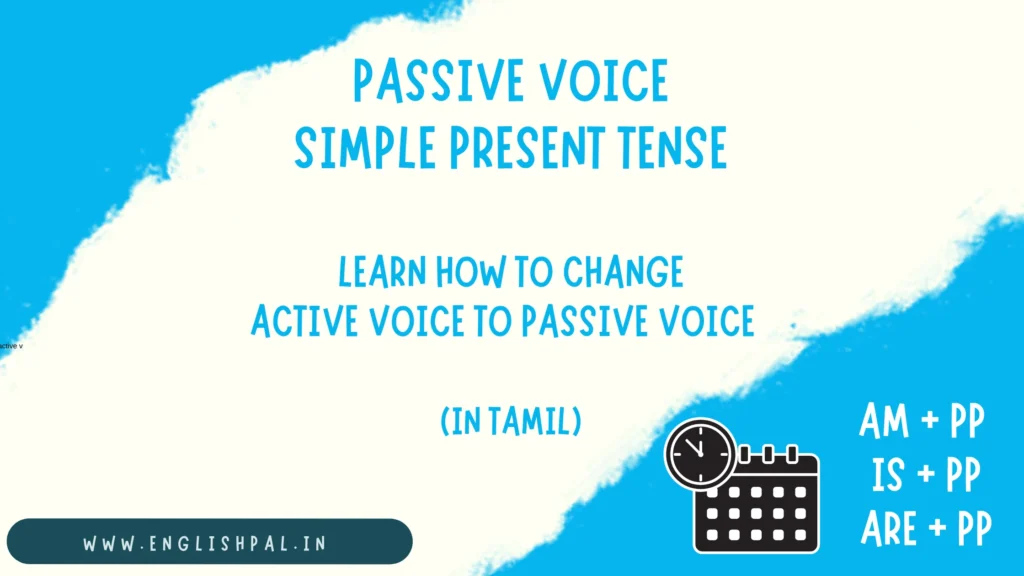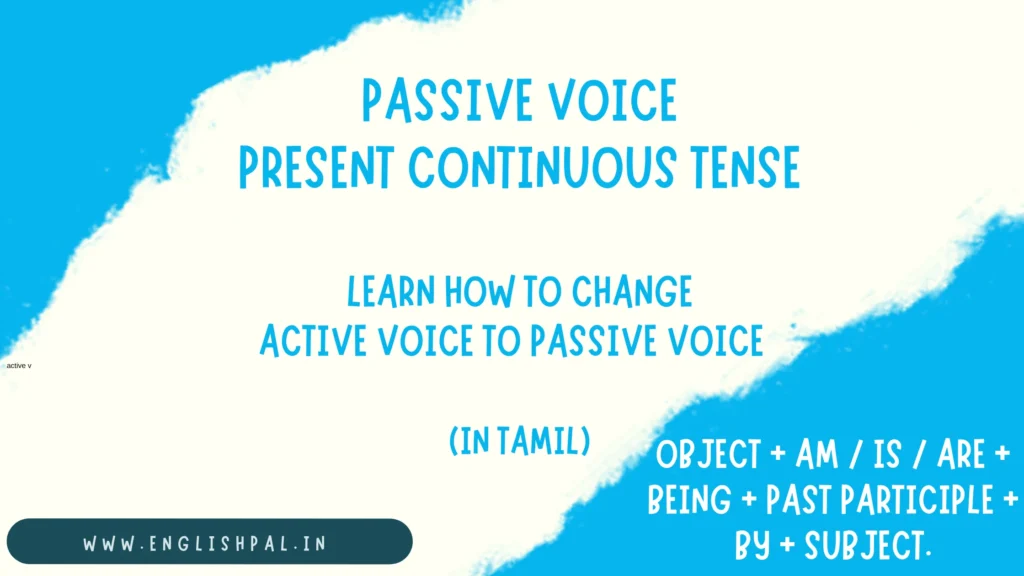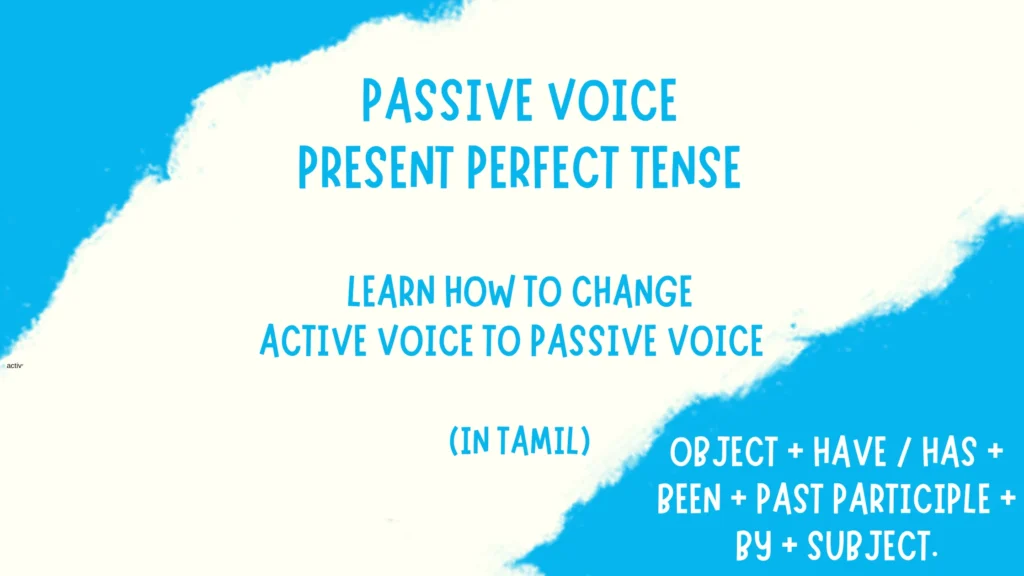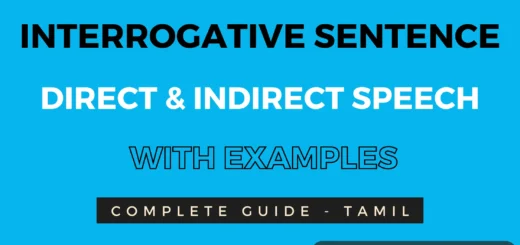Present tense passive voice rules with examples in Tamil
இந்த பதிவில் அனைத்து வகையான present tense வகைகளை எப்படி passive voice ஆக மாற்றுவது என்பதை முழுமையாக காண்போம்.
Passive voice formula for the simple present tense
நாம் simple present tense பற்றி tense பதிவில் படித்தோம் அல்லவா? அதனை எப்படி செய்யப்பட்டு வினையாக மாற்றுவது என்பதை ஒவ்வொரு படியாக இங்கு எடுத்துக்காட்டுகளுடன் காண்போம்.

Passive voice formula for the Simple present tense
ஒரு simple present tense மற்றும் அதன் எதிர்மறை வாக்கியம் மற்றும் வினா வாக்கியமானது செய்யப்பட்டு வினையாக மாற்றும் போது அவை கீழே உள்ளவாறு அமைந்திருக்கும்.
| The Simple present tense | passive voice form |
| The Simple present tense form | Object + am / is / are + past participle + by + subject. |
| The Simple present tense interrogative form | Am / Is / Are + object + past participle + by + subject ? |
| The Simple present tense negative form | Object + am not / is not / are not + past participle + by + subject. |
Simple present tense ஐ செய்வினையில் இருந்து செயப்பாட்டு வினையாக எப்படி மாற்றுவது?
The simple present tense ஐ செய்வினையில் இருந்து செயப்பாட்டு வினையாக மாற்ற கீழ்க்கண்ட முறையை பின்பற்றவும்.
Step 1
வாக்கியத்தின் இறுதியில் உள்ள செயப்படு பொருளை(object) வாக்கியத்தில் முதலாக கொண்டு வரவும்.
Step 2
துணை வினைச்சொற்களை செயப்படுபொருளுக்கு ஏற்றாற்போல் do, does இல் இருந்து am, is, are க்கு மாற்றவும்.
Step 3
present verb லிருந்து past participle verb ஆக மாற்றவும்.
Step 4
வாக்கியத்தில் முன்னால் இருக்கும் subject ஐ இறுதிக்கு கொண்டு செல்லவும்.
Step 5
subject க்கு முன்பு by சேர்க்கவும்.
அவ்வளவு தான். நாம் The simple present tense ஐ செயப்பாட்டு வினையாக மாற்றி விட்டோம்.
Examples of Active & passive voice rules for the simple present tense
1. Active voice: I eat an apple – நான் ஒரு ஆப்பிள் சாப்பிடுகிறேன்.
Passive voice: An apple is eaten by me. – ஆப்பிளானது என்னால் சாப்பிடப்படுகிறது.
3. A cow eats grass. – மாடு புல்லை உண்கிறது.
Grass is eaten by a cow. – புல்லானது மாடால் உண்ணப்படுகிறது.
4. She plays football. – அவள் கால்பந்து விளையாடுகிறாள்.
Football is played by her. – கால்பந்தானது அவளால் விளையாடப்படுகிறது.
5. He purchases the car. – அவர் காரை வாங்குகிறார்.
The car is purchased by him. – கார் அவரால் வாங்கப்படுகிறது.
6. Life teaches me. – வாழ்க்கை எனக்கு கற்றுக்கொடுக்கிறது.
I am taught by life. – நான் வாழ்க்கையால் கற்பிக்கப்படுகிறேன்.
7. I do not like her. – எனக்கு அவளை பிடிக்கவில்லை.
She is not liked by me. – அவள் எனக்கு பிடிக்கவில்லை.
8. Do they sell the shirts? – அவர்கள் சட்டைகளை விற்பனை செய்கிறார்களா?
Are the shirts sold by them? – சட்டைகள் அவர்களால் விற்பனை செய்யப்படுகிறதா?
9. We do not like you. – நாங்கள் உங்களை விரும்பவில்லை.
You are not liked by us. – நீங்கள் எங்களால் விரும்பப்படவில்லை.
10. Dhanush hates vegetables. – தனுஷ் காய்கறிகளை வெறுக்கிறார்.
Vegetables are hated by Dhanush. – காய்கறிகளானது தனுஷால் வெறுக்கப்படுகிறது.
11. Anirudh loves music. – அனிருத் இசையை விரும்புகிறார்.
Music is loved by Anirudh. – இசையானது அனிருத்தால் விரும்பப்படுகிறது.
அனைத்து வகை present tense இன் active voice அல்லது tense ஐ அறிய
Passive voice formula for the present continuous tense in Tamil

Passive voice formula for the present continuous tense
present continuous tense வாக்கியம் அதன் வினா வகை, மற்றும் அதன் எதிர்மறை வாக்கியத்தை செயப்பாட்டு வினையாக மாற்றினால் அதன் அமைப்பு கீழே உள்ளவாறு இருக்கும்.
| The present continuous tense | Passive voice form |
| The present continuous tense | Object + am / is / are + being + past participle + by + subject. |
| The present continuous tense interrogative form | Am / is / are + Object + being + past participle + by + subject ? |
| The present continuous tense negative form | Object + am not / is not / are not + past participle + by + subject. |
The present continuous tense ஐ செய்வினையில் இருந்து செயப்பாட்டு வினையாக மாற்றுவது எப்படி?
The present continuous tense ஐ செய்வினையில் இருந்து செயப்பாட்டு வினையாக மாற்ற கீழ்கண்ட முறையை பின்பற்றவும்.
Step 1
வாக்கியத்தின் இறுதியில் உள்ள செயப்படு பொருளை(object) வாக்கியத்தில் முதலாக கொண்டு வரவும்.
Step 2
துணை வினைச்சொற்களை செயப்படுபொருளுக்கு ஏற்றாற்போல் am, is, are க்கு மாற்றி அதனுடன் being சேர்க்கவும்.
Step 3
present participle லிருந்து past participle verb ஆக மாற்றவும்.
Step 4
வாக்கியத்தில் முன்னால் இருக்கும் subject ஐ இறுதிக்கு கொண்டு செல்லவும்.
Step 5
subject க்கு முன்பு by சேர்க்கவும்.
அவ்வளவு தான். நாம் The present continuous tense ஐ செயப்பாட்டு வினையாக மாற்றி விட்டோம்.
Examples of Active & passive voice rules for the present continuous tense
1. I am watching a movie. – நான் ஒரு திரைப்படம் பார்த்துக்கொண்டு இருக்கிறேன்.
A movie is being watched by me. – ஒரு திரைப்படமானது என்னால் பார்க்கப்படுகிறது.
2. She is preparing lunch. – அவள் மதிய உணவு தயார் செய்கிறாள்.
Lunch is being prepared by her. – மதிய உணவானது அவளால் தயாரிக்கப்படுகிறது.
3. We are playing basketball. – நாங்கள் கூடைபந்து விளையாடுகிறோம்.
Basketball is being played by us. – கூடைபந்தானது எங்களால் விளையாடப்படுகிறது.
4. She is not cooking the noodles. – அவள் நூடுல்ஸ் சமைக்கவில்லை.
The noodles are not being cooked by her. – நூடுல்சானது அவளால் சமைக்கப்படவில்லை.
5. Dhanush is singing a song. – தனுஷ் ஒரு பாடலை பாடுகிறார்.
A song is being sung by Dhanush. – பாடலானது தனுஷால் பாடப்படுகிறது.
6. We are seeing your exam results. – நாங்கள் உங்கள் தேர்வு முடிவுகளை பார்க்கிறோம்.
Your exam results are being seen by us. – உனது தேர்வு முடிவுகளானது எங்களால் பார்க்கப்படுகிறது.
7. They are searching for a missing ball. – அவர்கள் காணாமல் போன பந்தை தேடுகின்றனர்.
A missing ball is being searched for by them. – காணாமல் போன பந்தானது அவர்களால் தேடப்படுகிறது.
8. He is seeing you. – அவன் உன்னை பார்க்கிறான்.
You are being seen by him. – நீ அவனால் பார்க்கப்படுகிறாய்.
9. He is singing a song. – அவன் ஒரு பாடலை பாடுகிறான்.
A song is being sung by him. – ஒரு பாடலானது அவனால் பாடப்படுகிறது.
10 .They are helping the students. – அவர்கள் மாணவர்களுக்கு உதவி செய்கின்றனர்.
The students are being helped by them. – மாணவர்களுக்கு அவர்களால் உதவி செய்யப்படுகிறது.
11. Am I watching this movie? – நான் இந்த படத்தை பார்க்கிறேனா?
Is this movie being watched by me? – இந்த படமானது என்னால் பார்க்கப்படுகிறதா?
12. She is not controlling the students. – அவள் மாணவர்களைக் கட்டுப்படுத்தவில்லை.
The students are not being controlled by her. – மாணவர்கள் அவளால் கட்டுப்படுத்தப்படவில்லை.
Passive voice formula for the present perfect tense in Tamil
ஒரு present perfect tense ஐ அயற்கூற்றாக மாற்ற ஒரு சில மாற்றங்களை நாம் செய்ய வேண்டும். அவை என்னென்ன என தெளிவாக காண்போம்.

Passive voice formula for the present perfect tense
நாம் மேலே simple present மற்றும் present continuous tense க்கு எப்படி வினா மற்றும் எதிர்மறை செய்யப்பட்டு வினையாக மாற்றினால் எப்படி இருக்கும் என பார்த்தோம் அல்லவா? அதே போல் இங்கு நாம் present perfet tense க்கு கொடுத்துள்ளோம்.
| the present perfect tense | Passive voice form |
| the present perfect tense | Object + have / has + been + past participle + by + subject. |
| the present perfect tense interrogative form | Have / has + Object + been + past participle + by + subject ? |
| the present perfect tense negative form | Object + have not / has not + been + past participle + by + subject. |
The present perfect tense ஐ செய்வினையில் இருந்து செயப்பாட்டு வினையாக மாற்றுவது எப்படி?
The present perfect tense ஐ செய்வினையில் இருந்து செயப்பாட்டு வினையாக மாற்ற கீழ்க்கண்ட முறையை பின்பற்றவும்.
Step 1
வாக்கியத்தின் இறுதியில் உள்ள செயப்படு பொருளை(object) வாக்கியத்தில் முதலாக கொண்டு வரவும்.
Step 2
துணை வினைச்சொற்களை செயப்படுபொருளுக்கு ஏற்றாற்போல் have, has க்கு மாற்றி அதனுடன் been சேர்க்கவும்.
Step 3
past participle verb ஐ அப்படியே வைக்கவும்.
Step 4
வாக்கியத்தில் முன்னால் இருக்கும் subject ஐ இறுதிக்கு கொண்டு செல்லவும்.
Step 5
subject க்கு முன்பு by சேர்க்கவும்.
அவ்வளவு தான். நாம் The present perfect tense ஐ செயப்பாட்டு வினையாக மாற்றி விட்டோம்.
Examples of Active & passive voice rules for the present perfect tense
1. I have prepared this chutney. – நான் இந்த சட்னியை தயார் செய்துள்ளேன்.
This chutney has been prepared by me. – இந்த சட்னியானது என்னால் தயார் செய்யப்பட்டது.
2. We have seen this series. – இந்த தொடரை நாங்கள் பார்த்தோம்.
This series has been seen by us. – இந்த தொடரானது எங்களால் பார்க்கப்பட்டது.
3. They have made a mess in the hall. – அவர்கள் அறையை அசுத்தமாக்கி வைத்துள்ளனர்.
A mess in the hall has been made by them. – அறை அசுத்தமானது அவர்களால் ஏற்படுத்தப்பட்டது.
4. You have left the meeting. – நீ மீட்டிங்கிலிருந்து வெளியேறிவிட்டாய்.
The meeting has been left by you. – மீட்டிங் உன்னால் விடப்பட்டது.
5. He has spent more time on this research. – அவன் அதிக நேரம் இந்த ஆராய்ச்சியில் செலவிட்டுள்ளான்.
More time on this research has been spent by him. – இந்த ஆராய்ச்சிக்கு அவனால் அதிக நேரம் செலவிடப்பட்டுள்ளது.
6. She has done this work. – அவள் இந்த வேலையை செய்தாள்.
This work has been done by her. – இந்த வேலை அவளால் செய்யப்பட்டது.
7. You have not prepared for this exam. – நீ இந்த தேர்வுக்கு தயாராகவில்லை.
This exam has not been prepared by you. – இந்த தேர்வுக்கு உன்னால் தயார்படுத்த முடியவில்லை.
8. Has she completed the task? – அவள் பணியை முடித்துவிட்டாளா?
Has the task been completed by her? – பணியானது அவளால் முடிக்கப்பட்டதா?
9. I have accepted the job offer. – நான் பணி ஆணையை ஏற்றுக்கொண்டேன்.
The job offer has been accepted by me. – என்னால் பணி ஆணை ஏற்றுக்கொள்ளப்பட்டது.
10. The company has sponsored the project. – கம்பெனி திட்டத்திற்கு நிதி உதவி செய்துள்ளது.
The project has been sponsored by the company. – திட்டத்துக்கு நிதயுதவியானது கம்பெனியால் செய்யப்பட்டுள்ளது.
11. He has gotten the highest marks. – அவன் அதிக மதிப்பெண் எடுத்துள்ளான்.
The highest mark has been gotten by him. – அதிக மதிப்பெண்ணானது அவனால் எடுக்கப்பட்டுள்ளது.
Passive voice for the present perfect continuous tense in Tamil
The present perfect continuous tense ஐ செய்வினையில் இருந்து செயப்பாட்டு வினையாக மாற்ற இயலாது.
The present perfect continuous tense இல் ஒரு செயலானது இறந்த காலத்தில் தொடங்கி அந்த செயலானது தற்போது நிகழ் காலத்திலும் நடந்து கொண்டிருக்கும் சூழ்நிலைகளை குறிப்பிட உதவுகிறது. இங்கு நாம் அந்த செயலை அல்லது வினையைக் கொண்டு அந்த நிகழ்வை குறிப்பிடுவோம்.
ஆனால் செயப்பாட்டு வினையில் செயப்படுபொருளை (object) வைத்தே வாக்கியம் அமைப்போம். எனவே நம்மால் present perfect continuous tense ஐ செயப்பாட்டு வினையாக மாற்ற இயலாது.
இந்த பதிவில் அனைத்து present tense இன் passive voice ஆக மாற்றுவது எப்படி என்பதை step by step ஆக எடுத்துக்காட்டுகளுடன் தெளிவாக கண்டோம்.
Past tense & future tense passive voice பற்றி அறிய
Future tense passive voice rules with examples in Tamil
Past tense passive voice rules with examples in Tamil
Past tense & future tense active voice அல்லது tense பற்றி அறிய
Conclusion
நாம் இந்த பதிவில் simple present, present continuous மற்றும் present perfect tense ஐ எப்படி செய்யப்பட்டு வினையாக மாற்றுவது என்பதை எடுத்துக்காட்டுகளுடன் தெளிவாக விளக்கி இருக்கிறோம். மேலும் நம்மால் ஏன் present perfect continuous tense க்கு செய்யப்பட்டு வினையாக மாற்ற முடியாது என்பது பற்றியும் தெளிவாக காண்டொம். நாம் past tense மற்றும் future tense ஐ எப்படி செய்யப்பட்டு வினையாக மாற்றுவது என்பதை மேலே கொடுத்துள்ள இணைப்பை படித்து அத்தனையும் தெளிவாக புரிந்து கொள்ளுங்கள்.
இந்த பதிவினை பற்றிய உங்கள் கருத்துக்கள் மற்றும் இந்த பதிவில் ஏதேனும் சந்தேகங்கள் இருந்தால் அவைகள் வரவேற்கப்படுகின்றன. அவற்றை எங்களுக்கு comment இல் பதிவு செய்யுங்கள்.
நன்றி! வாழ்த்துக்களும் அன்புகளும்!



